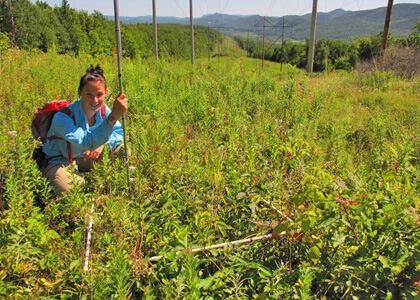Many people probably spend their lives without ever thinking about powerline rights-of-way or, perhaps, never even hearing of them. But for some migratory bird species, rights-of-way could provide essential habitat, which is why they have become the focus of my thesis research.
An electric powerline “right-of-way” allows an electric company access to a route where power transmission lines occur, even if it is privately owned land. In order to access and maintain the electric transmission lines, vegetation along rights-of-way must be managed so as not to interfere with the powerlines. This allows for these rights-of-way (ROWs) to remain in a shrubby, early successional state over long periods of time.
Here’s where the Audubon Society and I come in. Audubon Vermont recruited citizen scientist volunteers to look for high priority songbirds to see if our little feathered friends were using the shrubby areas created along ROWs. It turns out that six priority bird species, including Golden-winged Warbler, Eastern Towhee, Blue-winged Warbler, Field Sparrow, Prairie Warbler, and Brown Thrasher, were visiting these powerlines. So, as a graduate student with funding from the Northeastern States Research Cooperative (NSRC), I was called in to take a closer look.
Last summer, I led my field crew to ROWs across the Champlain Valley of Vermont to follow and map these priority songbirds to see which parts of the ROWs they were using. Eighty-seven birds and two months of very early mornings later, we were able to see where these shrubland birds liked to spend their breeding time. We then revisited all of these areas to collect innumerable thorn-induced wounds, as well as some detailed vegetation data. With all of this information, my research aims to paint a clearer picture of how these birds use habitat along powerline ROWs. So… why does any of this matter?
Only about 15% of conserved land in Vermont is publicly owned. This leaves the fate of much of the state’s land up to private landowners. Because of this, encouraging and implementing conservation and management activities among private landowners is very important. These particular songbirds rely on shrubby habitat to mate and reproduce. It is becoming increasingly hard for them to find this type of habitat in the Northeast, as the forest recovers and matures since the agricultural boom of the early 1900s. Shrubland occurs as a transitional period when field becomes forest again, so it requires repeated disturbance to be created. Using areas like powerline ROWs is convenient because they are already managed or “disturbed” regularly and remain in transition.
By analyzing the patterns of how birds use this habitat and what management is already being done, I can suggest management techniques that might better serve these species. Audubon Vermont and I have collaborated on a report that was submitted to the Vermont Electric Power Company, which manages over 3,000 hectares of ROW land in Vermont. The report summarized findings and recommended best management practices for these birds. With this information, we hope that future management along these powerline ROWs will create more suitable habitat for these declining shrubland songbirds.
